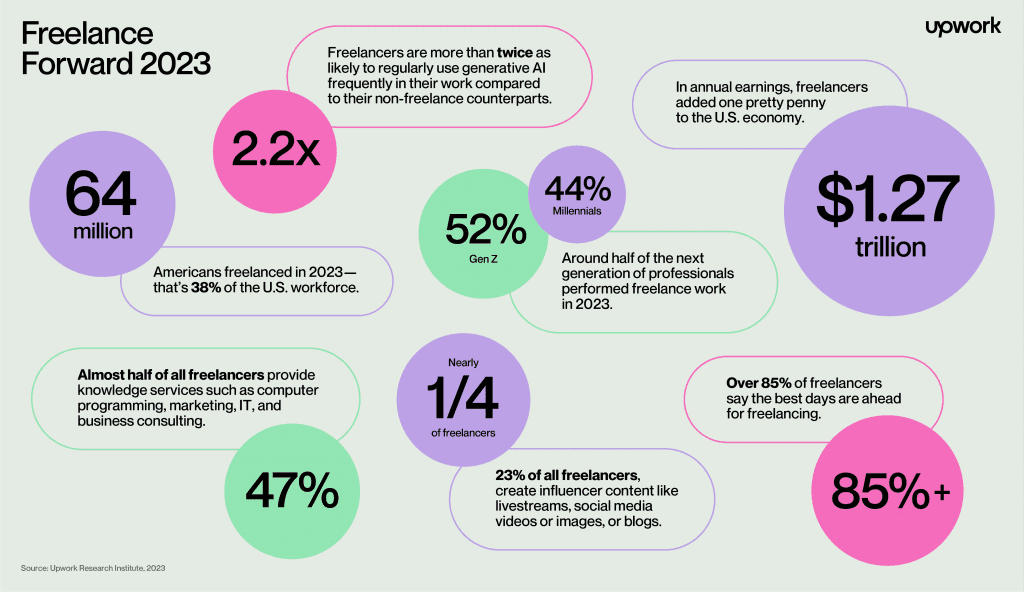The rise of the independent workforce is redefining traditional job market paradigms, setting new records in terms of participation and influence. This phenomenon is rooted in several interconnected factors that are driving its rapid expansion.
One of the main drivers of this growth is the digital revolution. With the advancement of technology and the spread of global connectivity, remote work has become not only viable but also highly effective. Online platforms and collaboration tools allow professionals to carry out complex projects from anywhere in the world, breaking down geographic barriers and expanding access to job opportunities.
Furthermore, the search for flexibility and autonomy has led more and more professionals to opt for independent work. The traditional full-time employment model is being challenged by a generation of workers who value the freedom to manage their own time and choose the projects they want to be involved in. This is especially evident among millennials and Gen Z, who are shaping job market trends with their preferences for a more balanced and adaptable lifestyle.
On the other hand, companies are also recognizing the benefits of engaging with independent workers. The on-demand nature of the new workforce allows companies to quickly access specialized skills as needed, without the expenses associated with full-time hiring. Additionally, independent workers often bring a fresh and innovative perspective to projects, enriching creativity, and diversity of thought within organizations.
In the United States, the power of independent workers is truly setting new records and shaping the future of work. According to the Freelancing in America 2023 report, produced by Upwork and Freelancers Union, more than a third of the US workforce is independent, representing an 8% increase over the last year. This growth is fueled by the country’s strong entrepreneurial culture, high demand for specialized technology talent and growing preference for a more flexible lifestyle.


Source: Upwork Study Finds 64 Million Americans Freelance in 2023, Adding $1.27 Trillion to U.S. Economy | Upwork Inc.
In Latin America, the independent workforce is gaining ground in a remarkable way. Countries such as Brazil, Mexico and Argentina have seen a significant increase in the number of professionals choosing to work independently. According to data from Freelancer.com, one of the largest freelancing platforms in the world, Latin America recorded a 25% growth in the participation of freelancers between 2019 and 2023. This growth can be attributed to several factors, including the advancements in technology, which made remote work possible in several areas, the search for flexibility and autonomy on the part of professionals and even economic instability in some countries, which boosted the search for alternative income.
Speaking of Brazil, freelance work already represents approximately 32% of the workforce, indicating a significant change in the country’s employment scenario. This significant increase is driven by several factors, including the search for professional flexibility, the advancement of technology that facilitates remote work and the need to supplement income in a challenging economic context. The growth of independent work reflects the adaptation of Brazilians to new forms of work and the appreciation of autonomy and freedom in pursuing a professional career.
Additionally, Latin American companies are also recognizing the benefits of engaging with freelancers. They find this model an effective way to access specific skills, reduce operational costs and quickly adapt to market demands.
In Europe, the freelance work scene is equally vibrant and diverse. Countries such as the United Kingdom, Germany and Spain have been leaders in this movement. According to Eurostat, the European Union’s statistical agency, the number of self-employed workers in the region increased by more than 45% between 2008 and 2022. One of the main reasons for this growth is the increasing digitalization of the European economy.
With the advancement of technology, more and more professions can be carried out remotely, which opens doors for freelancers to work in a variety of sectors, from information technology to graphic design and business consultancy. Furthermore, work flexibility policies, such as the right to remote work, have encouraged many professionals to explore the freelance model.


This growth is mainly driven by younger generations, with 53% of Gen Z workers currently working as freelancers – more than any other generation. At the same time, more millennials are freelancing full-time (40%), which suggests that this practice is becoming a lifestyle choice rather than a simple financial supplement.
In recent years, we have witnessed a significant transformation in the world of work, with the impressive rise of the independent workforce. This phenomenon is not just a passing trend, but rather a structural change that is redefining the way companies operate and professionals engage in the job market.
The independent workforce is emerging as a towering force in the global corporate world. From Latin America to Europe and the United States, the numbers speak for themselves. The exponential growth of this type of work is driven by technology, the search for flexibility and the need for companies to access specialized talent in an agile and efficient way. Given this scenario, there is no doubt that the future of work will be increasingly characterized by the freedom and autonomy of professionals.


